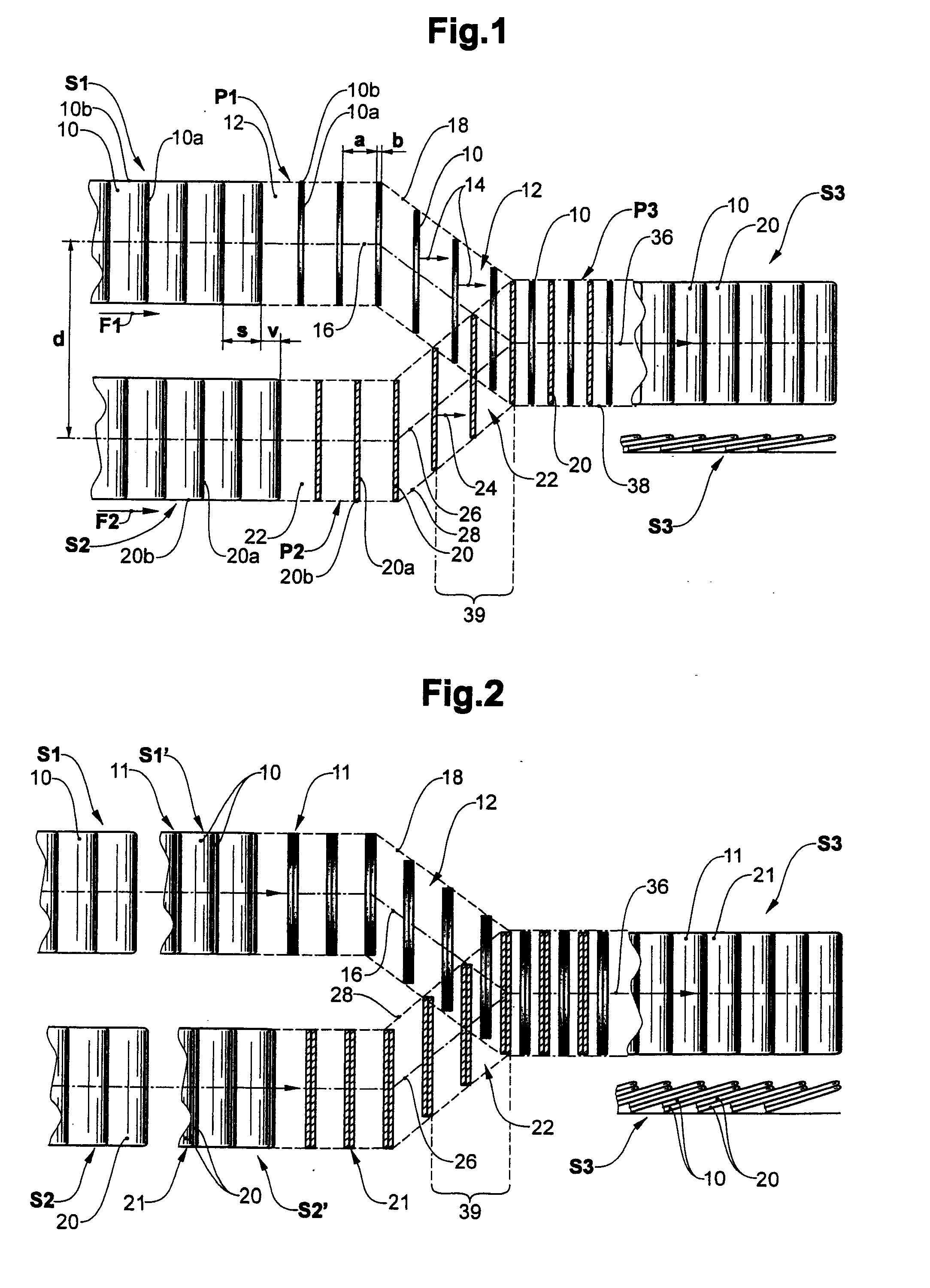[0012]The method according to the invention assumes that flat products are conveyed in two imbricated flows which are spatially separated from one another, i.e. in a compact formation with a certain overlap of the products. Since the products normally lie in an imbricated formation, the surface normals as a rule are orientated essentially vertically, and thus, essentially perpendicularly to the conveyor direction. The flows are received by an intermediate conveyor and are conveyed further as a first or second product flow. Thereby, space intervals are created between individual products or at least between groups of products, which are conveyed directly overlapping one another in the initial formation. Space interval is to be understood in that in each case two products are distanced to one another, so that at least one front surface or rear surface of a product is preferably essentially completely exposed. In each case, one or more products of the respective other product flow may be introduced in a gentle manner into these space intervals without
rubbing on one another. In order to avoid a space-consuming and mechanically burdening pulling-apart of the products in the plane of the products, the orientation of the products, at least of one of the product flows, is changed such that its surface normals point essentially in the horizontal direction directly before the unification of the product flows. This orientation change may be effected without a great effort by way of using
gravitational force. A spatially compact formation with space intervals arises without having to significantly accelerate the products in the conveyor direction. The products of at least one of the product flows are then inserted with an essentially
horizontal orientation of their surface normals or in a hanging or standing position, into the space intervals within the other product flow.
[0018]As an alternative, the space intervals may be produced by way of the products being introduced into conveyor compartments of a rotatable conveyor drum individually or preferably in groups. They are introduced from above, preferably on account of gravity, with a horizontal alignment of their surface normals. After depositing in the conveyor compartment, the surface normal of the products points in the direction of the surface normal of the
support surface of the conveyor compartments, whose direction preferably corresponds to the conveyor direction. A conveyor compartment in each case receives products from the first and second imbricated flow. These are fed at different axial positions and are pushed onto one another in the axial direction by way of an additional pusher means or by way of gravity. If the
axial displacement of the products from the first product flow is effected before the feeding of the products from the second product flow, then a particularly gentle treatment of the products is effected, since one avoids the products
rubbing over one another.
[0020]The inventive device for carrying out the method includes conveyor means which are capable of receiving the products from the first and the second imbricated flow and conveying them into a first product flow or into a second product flow. Such conveyor means are for example
grippers, pockets or also conveyor compartments of a conveyor drum. The products are conveyed such that the space intervals described above are created at least for a short time. Furthermore, means for displacing the products of the first product flow are present, which move these relative to one another in a plane running essentially perpendicularly to the surface normals, into the space intervals within the second product flow. By way of this, the distance of the product flows is also reduced and finally a common product flow consisting of products from the first and the second imbricated flow are formed. These means may, for example, be realised by way of conveyer paths of the
grippers or pockets, which approach one another. With a conveyor compartment which receives products from the first or second imbricated flow at different axial positions, these means may be realised by way of a pusher acting in the axial direction. Alternatively or additionally, the
gravitational force may also be utilised, e.g. by way of the products sliding from above into pockets, grippers or conveyor compartments, in which products are already located.
[0022]The invention permits a gentle, space-saving unification of two product flows, and, given an equal conveying of several products, permits the achievement of a significant increase in the capacity. For this, to some degree conveyor devices known per se are applied in a new manner. For this reason, the invention may be realised without any great design effort.
 Login to View More
Login to View More 


